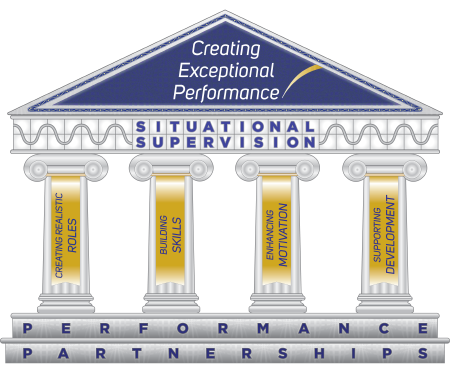 Staff Motivation and Engagement: How's That Working for You?
Staff Motivation and Engagement: How's That Working for You?
Lee Davis, Training & Organizational Development Consultant
In Level 1 of the Strategic Leadership Program, my co-facilitators and I present the Creating Exceptional Performance model. This is no quick fix or magical formula. Instead, the model demands a thoughtful reconfiguring of how you approach work and interact with your employees. When presenting this information, I am often met with resistance or charges of impracticality: No one has the time, one’s departmental culture wouldn’t support such an effort, we simply need to focus on work, and so on.
For leaders out there who prioritize productivity and the bottom line over developing staff, I would ask, most respectfully, how’s that working for you? Do you have attrition or retention? Do you enjoy growth and innovation, or is your department and culture stagnant? If your current approach is getting negative or mixed results, I encourage you to consider a more holistic approach, one that ensures your efforts will reap reward.
When we focus on productivity we become so task-oriented that we forget about the people performing the tasks. This is great for accomplishing a great deal of work very quickly, but it isn’t sustainable. Employees experience burnout, which ultimately leads to the exact thing we’re trying to avoid: decreased productivity.
I do understand that trying a new approach may be daunting when deadlines are looming, but the Creating Exceptional Performance model guides us piece-by-piece through creating long-term relationships with our employees that set us all up for success.

Performance Partnerships
The foundation of the model is Performance Partnerships, which is the handshake — the acknowledgement, the understanding, the reciprocation — that ensures that all needs are being met on both sides. The moment that there’s a crack in that partnership, then the entire structure of your organization is in danger of becoming misaligned or even crumbling.
What can an employee or middle manager do to create successful performance partnerships? It can be as simple as checking in with your people daily to see how things are going, working with individuals to create a tailored career plan, or regularly creating opportunities for staff to stretch within their roles. The key is to build connections that promote success. With performance partnership, you offer that handshake so that everyone feels satisfied, respected, and fulfilled through their interactions with you.
The Pillars
The pillars present specific areas for managers to focus their efforts on. In many ways, these are the known and fundamental tasks of the manager — creating realistic roles, building skills, enhancing motivation, and supporting development — but they rest on, and grow out of, performance partnerships. Without that foundation, our efforts in these areas will falter or even fail.
If you have been through SLP, we have walked through many aspects of these tasks together. If you have not, or if need a refresher, there are myriad resources online.
- POD’s employee development and coaching page provides links to many relevant resources, tools, and classes.
- For building specific skills, POD’s competency guide identifies competencies in five areas of excellence (individual, interpersonal, operational, leadership, and organizational) and maps each competency to classes and other development resources.
- POD’s certificate program offers excellent skill building and development opportunities for staff, with certificate completion counting as six months of experience for related positions at the UW.
- The succession planning toolkit walks you through steps for identifying staffing needs and the people with the skills and potential to perform in future roles, including identifying competencies, skills and institutional knowledge that are critical success factors.
- Visit UWHR’s employee recognition webpages for ideas for acknowledging your staff’s hard work.
- Learn from past Tri-Campus Institute participants by discovering their best practices and key ideas for fostering engagement, cultivating talent, promoting development, and creating mentoring opportunities.
Situational Supervision
Capping the pillars is situational supervision, which requires us to acknowledge that circumstances—and people—are dynamic. There is no cookie cutter approach that will work every time. That means understanding your employees, their motivations, and their stressors, understanding why they’re here and what they’re trying to accomplish, and bringing that understanding to each interaction.
With situational supervision, your willingness to know your employees as human beings, and not just as numbers or as cogs in a wheel, is crucial. Now, we may think we don’t have time for this kind of approach. We may think this will deter productivity and improved performance. The truth is that exceptional performance is created by investing our time, energy, and effort into understanding and supporting our people as people.
A Spirit of Excellence
There’s a spirit of excellence that we experience when people aren’t just doing their job but are deliberately arriving to work with intentionality and are committed to purposefully and joyfully engage in any task with unrelenting passion! This outward mindset is infectious, and it will garner a well-respected and highly collaborative team and produce an environment of harmony, excellence, and compassion.
As a leader, you can promote that spirit of excellence — and create exceptional performance — by cultivating humanity and compassion, true partnerships, and an environment that is comforting and amenable. Stop worrying about whether the work is getting done or how fast. Instead, refocus your energy and shift your intent to supporting your employees, partnering with your employees, learning about and treating your employees as people — and then step back and watch them exude their magnificence and unleash their game-changing spirit of excellence.


